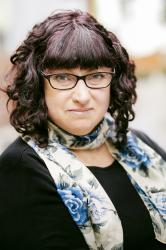Victorian Opera: The Flying Dutchman
Opera at the magnificent sea-side Palais Theatre with the audience wearing 3D glasses! Victorian Opera are sure giving us a new look at Wagner’s The Flying Dutchman.

Close to his home in Norway, captain Daland (Warick Fyfe) takes shelter in a fjord where a huge and red ship pulls alongside. With the promise of riches, he doesn’t notice its ghosty appearance and offers his daughter (Senta, Lori Phillips) to the Dutchman Captain (Oskar Hillebrandt, who has sung the role over 400 times in 45 productions around the world). This actually turns out better than expected because on shore Senta dreams of the legend of The Flying Dutchman ghost ship and its dreamy captain, but she already has a suitor, Eric (Bradley Daley).
Dutchman is one of Wagner’s early works and is difficult to stage because the first act is set on a moving ship mid-ocean and the final act brings ghosts. The problems have been conquered with a team of animators and designers from 3D Image Design & Creation Deakin Motion. With three screens on the stage, we’re brought onto and into the ships and it feels almost like being in a live computer game.
This is combined with a simple and somewhat traditional design of heavy wood (Matt Scott and Christina Smith) that makes it feel like we’re at the Palais not long after it opened in 1927. The combination of the two styles works wonderfully to create a solid and unmovable world that’s lost to a world of dreams. Unfortunately the costumes feel out of place. Unnecessarily attached to the late nineteenth century, the women look especially frumpy and not part of the stage world that feels so at home in the huge and crumbling Art Deco theatre.
Although the design is what’s bringing attention to this show, there’s no holding back from Victorian Opera in the creation of Wagner’s opera.
The absolute highlight of the work is the Australian Youth Orchestra, who almost overfill the pit that’s not much lower than the stage. Conductor Richard Mills leads them in creating a sound that fills the huge space. The sounds’s not as rich as a professional orchestra who know Wagner inside out, but they bring a freshness to the music that’s rarely heard. (I should also say that I was close enough to hear Mills singing along, so I don’t know if the sound travelled to the back of the C Reserve balcony.)
On stage, Fyfe (who was a favourite in Wagner’s Das Rheingold in 2013) continues to master Wagner as a singer and an actor, and Phillips holds onto Senta’s indecision and dilemma until the last scene. Director Roger Hodgman lets the story come first on the stage by ensuring that the projections only take over when they need to and by letting everyone in the chorus be as important in the telling as those up front.
Wagner’s music is demanding to listen to and his stories about how humans and the supernatural/divine interact are equally as demanding. This combination of traditional opera story-telling, young orchestra and whizz-band new technology grasps it all. This is the kind of production that makes old-school opera exciting and fresh.
There are only three performances and the only one left is this Thursday, 19 February.


